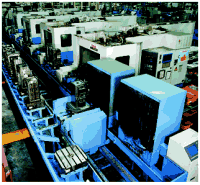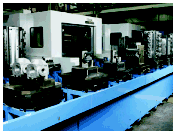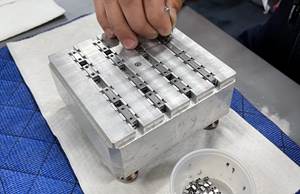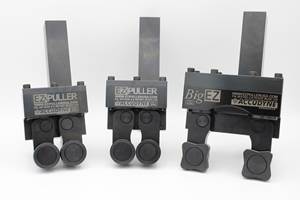High Automation for Low Volume
Many people think flexible machining cells are for high production, but this shop finds just the opposite. Here's how they've grown their cell to meet the needs of their work.
Ask anyone where flexible automation applies and chances are they'll say high volume machining, even though the very term "flexible" implies something else. This no doubt stems from the early days of FMS technology where, while the concept was theoretically aimed at quantity-of-one machining, the systems were so complex and expensive that only large scale manufacturers could afford to shoulder the keep.
The technology is very different today, however. These are systems built with standard horizontal machining centers, modular pallet handling systems and surprisingly easy-to-master cell controls. Though not yet quite "plug-and-play," the integration of these components is a snap relative to their more complex predecessors. Indeed, the machine tool builder typically handles all the integration, freeing the user of the worry of how all the pieces are going to work together.
And in the right applications, the total cost compares favorably to conventional stand-alone machines attended by a normal complement of labor. Moreover, shops can start small—even with a single machine—and let the system grow with their needs, adding more machines and pallets as they go.
But shops thinking about moving to flexible cells will probably have to gain better control over the machining process, seeking higher levels of predictability and consistency than are strictly necessary with stand-alone machines. Whether or not there are people around, a flexible cell is in essence an unattended machining process, and everything from workholding to tool control to feeds and speeds must be carefully engineered on the front end if a shop hopes to realize the potential of their investment.
Here's how one mid-size manufacturer started small with this concept, and has since grown it into one of their most effective manufacturing strategies.
Seeking Responsiveness
ISI Norgren is itself in the automation business. The company first made its name by making "iron hands," the grippers that have for years been used on automotive welding and assembly systems. Unlike most companies in the automation business, however, ISI's concept is to function essentially as a standard, off-the-shelf component supplier. As such, they do very little systems integration, leaving that to other systems builders that ISI regards as their core customer base. Among their many products are pneumatic scissor lifts, pneumatic control valves, flow controls, air cylinders, modular conveyor systems, standard roller sections, power clamps for welding fixtures, and vacuum cups—literally thousands of different part numbers that are for the most part sold from a catalog.
So for this automation company, manufacturing efficiency is paramount to their competitiveness both in terms of cost and in flexibility, since the ability to deliver on short order can often be the difference between getting an order or not. ISI really has only two options in providing the delivery performance the business needs to thrive: They can do it with inventory, or they can do it with a highly responsive shop floor. They've gone the high inventory route in the past, but that was costly and still not very effective. The business also has become more complex through growth and their increasing penetration of the European market, which has very different business cycles than those of the United States.
So ISI has continually sought out manufacturing solutions that are both more efficient and more flexible. One expression of that objective is a flexible machining cell that today consists of four Ultra 550 horizontal machining centers from Mazak (Florence, Kentucky) and a 40-pallet Palletech material handling system. While ISI sometimes manufactures in lots up to several thousand pieces, this system is saved for much lower volume work. A few hundred pieces are typical. But volume isn't the critical issue here, it's the ability to provide a flexible bridge between forecast-oriented production and the need to serve customers' urgent requirements that defy their best made plans.
ISI has found that this system isn't for every part in the shop, and selecting the right work is crucial to success. According to production manager Paul Morse, the highest return comes on pieces that run frequently enough to justify an investment in dedicated fixtures and that otherwise would require multiple setups to do the same work on vertical machining centers. "We use it a lot for more repetitive work with multi-face machining," he says. All fixtures for the fastest moving parts are left up on the pallet handling system, and all part programs are permanently stored in the cell control, in order to react quickly to spot orders. Once the program is activated and the material loaded, they are ready to go.
Now leadtime for these parts can be just a few hours. But it's taken a lot of careful planning to get ISI to this point.
Production On Pallets
It certainly helped that ISI was no stranger to the general concept of unattended machining. "We've been machining on pallets almost from the start [of that technology]," says Mr. Morse. "We first tried something like the Mazak cell fifteen years ago with a machining center and carousel pallet changer."
Along the way, ISI learned that under the right circumstances it was possible to leave a fixture set up on a pallet and to bring that unit back into production with virtually no time lost to internal setup or the need for directly attendant labor. But from a practical standpoint, that ideal was only achievable if they had the opportunity to work out a "no-surprises" process where workpiece location was sufficiently repeatable, tool offsets were accurately established, tool wear was predictable and manageable, and workpiece material was consistent enough not to undermine the carefully achieved harmony of all these process variables.
These are all, of course, the very same components that are necessary to master in any well engineered metalcutting process, which should be done in any case. But often they are not. Taking the operator away from the machine makes them mandatory.
For these reasons, and others having to do with economic practicality, ISI chose to start their cell small. The system started out three years ago with a single machining center with eight pallets, all under control of the machine's standard CNC. That afforded ISI the opportunity to establish which workpieces and methods work best, but still in a relatively simple technical environment. With that experience digested, the next year they added two more machining centers to the system, 32 more pallets and a separate cell control. Then last year they added one more machine, which better balanced the machining and material handling capacity.
Matters Of Practicality
How do they make it work? According to Mr. Morse, that's not as demanding a job as one might think. Most of all it takes an understanding of which process components are going to be critical, and when, and then to take appropriate measures to head off problems before they occur.
Tool management is important, and ISI seeks to standardize wherever they can. For instance, pockets 1 to 20 on each machine use exactly the same set of tools. Higher number pockets, then, are used for any other additional tools necessary to process individual workpieces.
The quality of tools is also critical. ISI does a lot of testing to see which tools perform best in a given application. But perhaps even more important, they look to see how consistently a tool performs over time. ISI uses tool life management to monitor time in the cut, which automatically removes a tool from service after its limit has been reached. And quality will suffer should a tool dull before its allotted time. For these reasons, ISI will not blink at using a tool three times the price of the cheapest option, if it delivers the performance. It's an investment that pays back many times over.
To keep setup time to a minimum, tool length offsets are often established with the "Tool Eye" tool presetting system on the machining centers. This is a means by which tool lengths can be measured automatically or semi-automatically via a touch sensor mechanism. Once the tool, or a set of tools, is measured by the sensor, the offsets can then be stored either at the individual machines or at the cell control.
However the tool position is established, they typically can machine with a new tool without having first to take a trial cut. The only exception is with fine finish boring bars where they are holding tolerances of 5 "tenths" (0.0005 inch).
In precision work, finding the material can be as important as finding the tools, and that also requires some thought. By leaving fixtures permanently set up on pallets, once workpiece location datums are dialed in, that job need not be done again. Variance in the material itself is another matter, however, and one not so easily controlled. So ISI routinely does things like use investment castings rather than sand castings, which is a bit more expensive, but it's a cost Mr. Morse believes that he more than recoups by the time the parts are out the door. "With sand castings, it's kind of a witch hunt to know where the material is and how consistent it will be," he says. That's going to affect tool wear and surface finish, and they'd rather avoid these variables if they possibly can.
The Human Element
The strong emphasis on process engineering does not mean that cell management is strictly the domain of a manufacturing engineering department. Shopfloor workers are intricately involved in day-to-day management of the system and in its improvement.
It takes surprisingly little manpower to keep the system running—only two people per shift. One person concentrates on scheduling, programming and setup while another person handles workpiece loading and unloading. The team works a 10-hour shift, followed by another team that also works for 10 hours. The shifts overlap half an hour to make sure that work-in-process is securely handed off, and then the system typically runs for 2 hours unattended at the end of the day.
Mr. Morse believes that engagement of the operators is crucial. They are strongly encouraged to weed out process problems wherever they can, and to directly seek out vendor support to solve them. Nobody needs permission to become involved with continuous improvement.
All part programs are resident in the cell control, and operators can do modifications right at the machine. That's not to say that they want to do a lot of revisions to proven part programs. But they will have frequent circumstances where some editing is required—for instance, where not all the workpiece stations on a tombstone are loaded—and they want the flexibility for the operator to handle that situation on the spot.
The cell control is also where the production schedule is maintained. Pallets can be sequenced in a simple order of priority, or they can be more randomly scheduled based on a designation of "normal," "rush" or "hold for later processing." And a hot job can be put ahead of all else by flicking a switch at the cell control. If one of the machines goes down for any reason, the control can automatically reallocate pallets to any machine in the cell that is appropriately tooled for that particular job.
Continuous Learning
As ISI works more with the technology, they learn more about where it fits best. As it now stands, ISI uses it to deal with production shortfalls within the plant's standard 21-day manufacturing cycle. "This is not a production machine," says Mr. Morse, "it's a machine that replenishes my buffers."
And though ISI keeps a couple of tombstones fit with standard vises "just for crisis work," they have found through experience that the best return comes with parts that repeat on a regular basis. They've experimented all along the way, and continue that practice. For instance, they've tried kit machining, where all the different parts are loaded on a single tombstone and machined together. It's an idea that is particularly appealing from a scheduling standpoint. But for the sake of efficiency, Mr. Morse recommends it only for very low volume products.
Interestingly, ISI never applied a formal cost justification to the acquisition of this technology. They bought it, first to boost both their responsiveness and their efficiency, but also because the company wants to continue to be a leader in technology—not just the technology they sell, but also the technology they use on their own shop floors.
A lot of those benefits are difficult to measure, but ISI does not appear to be disappointed on any count. Bottom line, says Mr. Morse, "It helped us grow without adding people." That speaks in part to efficient part processing. But it speaks just as loudly to a shop floor with the flexibility to deliver product when a customer needs it.
Related Content
Fearless Five-Axis Programming Fosters Shop Growth
Reinvestment in automation has spurred KCS Advanced Machining Service’s growth from prototyping to low-and mid-volume parts. The key to its success? A young staff of talented programmers.
Read MoreNiche Work If You Can Get It: A CNC Machine Shop Crafts Its Own Destiny
The latest innovations in metalworking aren’t always related to CNC automation or robotics. For Rosenberger North America, a 2022 Top Shops Honoree, it is the company’s niche processes that create the biggest successes.
Read MoreZero-Adjustment Bar Pullers Simplify Turning Automation
Spring-loaded grippers and adjustable programming are enabling bar pullers to fulfill their promise to save time and money in CNC turning automation.
Read MoreChoosing a Five-Axis Machine Tool With Automation in Mind
While much focus is placed on the machinery that moves parts, the features most important for automating five-axis machining are arguably found in the machine tool itself.
Read MoreRead Next
The Cut Scene: The Finer Details of Large-Format Machining
Small details and features can have an outsized impact on large parts, such as Barbco’s collapsible utility drill head.
Read More3 Mistakes That Cause CNC Programs to Fail
Despite enhancements to manufacturing technology, there are still issues today that can cause programs to fail. These failures can cause lost time, scrapped parts, damaged machines and even injured operators.
Read More









.jpg;maxWidth=300;quality=90)













.png;maxWidth=300;quality=90)








.jpg;maxWidth=970;quality=90)